Rick's b.log - 2020/04/24
You are 18.216.70.205, pleased to meet you!
Rick's b.log - 2020/04/24 |
|
| It is the 21st of November 2024 You are 18.216.70.205, pleased to meet you! |
|
mailto: blog -at- heyrick -dot- eu
Apparently something inside the speedometer has stopped working. So a second hand part was fitted (cost €40) which has two upsides. The first is that the speed of mine, for some reason, goes from 0 to 100 with 50 (the maximum the car can do flat out downhill) not even halfway over. The new speedometer goes from 0 to 80 and has 45 marked clearly. It'll remain to see how accurate it is. The old one tended to read about 5-8km high, which wasn't so friendly to other road users in a 30kph zone!
She still makes the rumble in reverse (not as much though), but since the bearings have been changed and the wheels checked, I'm not going to worry so much about it. It might be the brakes vibrating or something? I don't know.
Total cost - 40 for the dashboard, 135 for two and a half hours, 1,50 eco-tax, and 35,30 regular tax for a total of €211,80 and a working car. And... there's nothing on the bill about the pick up and delivery. Either that's rolled into the labour time (hard to imagine, surely it would take him an hour to get there?) or it's just something that they offer? Either way, I've spent around €600 on Felicity recently so she better work for a while without incident. You listening, Flick? Hello? Hello?
I have the old dashboard here. I guess sometime I'll take it apart for blogfodder... and have a plentiful supply of little 12V lamps!
The first step is to remove the lid. This is easy, hold it about 45° open, and you'll see two lugs line up with slots in the part holding the lid in place. When they are aligned, a gentle tug will free the lid.
Next, five screws holding the top in place. These are hidden behind five screw covers mounted flush with the body. As I wasn't worried about visual blemishes, I shoved the pointy end of a sharp meat knife into the edge to loosen each one, then used the edge of the knife (horizontally) to pop them out.
That done, it's a simple matter to remove the screws, however do be aware that they are pretty far down so you will need a long but narrow screwdriver (flat or cross head, either will work).
You'd think that would be enough. But no, the top will remain firmly in place. There are clips holding the two parts of the casing together. Thankfully the clips are big and robust, so poke a flat head screwdriver between the two parts towards the back and flip one of the clips open.
Looking inside you will see many screws. Thankfully you do not need to remove them all. If you look carefully you will see that some appear to be holding the metal sides of the oven while others appear to be doing nothing. The ones holding the metal sides (as in the one on the right in the picture below) can be ignored, that's exactly what they are doing.
The others? They're the ones you need to pay attention too. There are two at the back of the oven, two at the front of it (you can ignore the earth screw), one in the centre front, and two either side of the motor.
Next, unscrew the drive board (the little circuit board beside the motor). This is so you can get access to a screw holding the black plastic mount against the outer body. It's hard to spot, so here's a photo of it. It's not the one under the ribbon cable, it's the one under the smaller red wire.
Once that is done, the entire innards of the bread maker can be lifted up at the back and rotated to give access to the drive mechanism. It is a little fiddly, you'll need to ease the unit beyond some plastic protrusions at the back of the case, but be gentle and it'll lift up. If it resists lifting up, check that you have not missed a screw.
Now, this next part is a pain in the ass so go make yourself a tea. I did, and as I was doing so I remembered where the other screwdrivers were. Tea Gets Stuff Done!
You'll need to unbolt both of the black drive wheels and remove the old belts. Then hook the smaller of the new drive belts between the two upper parts (that turn the paddles). Don't do anything with the small wheel, just pop the belt up there as it needs to go behind the larger belt.
Next, thread the larger belt around the larger wheel and hook the excess around the motor's little cog. Then, using imagination and brute force, you will have to get the larger wheel back onto it's spindle.
Then, you get to do it all again with the smaller wheel. I told you you'd need tea.
Once both are in place, fit the metal lugs if they happened to fall off in all the excitement (as shown in the above picture), and then refit the bolts. There is a large washer that fits against the wheel, then a little ring, and finally the bolt. Do them up tight.
Now it is time for reassembly. If you notice little round black things rattling around the casing, these are thermal guards that fit between the plastic casing and the metal body for the four screws around the oven. Here is a picture of the body in place with the guard visible between the metalwork and the white body plastic.
Replace all the screws holding the unit into the casing. Do them all up tight, even that one by the motor that is hard to get access to.
Next, the screw holding the black plastic thing in place.
Then the two holding the electric board in place.
Gently position the top part of the casing in sort of the right place, and then holding it there, pick up the entire bread maker and shake it. You should not hear anything rattling around inside. If you do, you'll need to find out what and rectify it. Pray that it isn't one of the black thermal thingies as that will mean unscrewing everything.
Now for the top. Put the front clip in place and swivel the top down until it clicks.
Of course, I'm lying to you. You'll find it's a monumental pain in the ass (fetch more tea!) because the two halves of the casing need to line up perfectly in order for it to fit.
AND...
The heat-safe part of the top (the darker part) also needs to line up with the sides of the oven. You might need to persuade it to fit.
Once it all clicks, it's just a matter of doing up the five screws and poking the screw covers back into place.
That done, the final part of the reassembly is the lid. Notice that one of the lugs is angled. Slot the non-angled one into the hole (this should be the left one), then line up the angled lug with the slot. Give it a firm push, and you're done.
Check one. Pick it up and shake it. Nothing rattling? I know you did this before, but it doesn't hurt to doublecheck.
Check two. Plug it in. Does it power up and beep? It should...
Check three. Choose the pasta dough cycle (#7) and press Start. The drive mechanism should begin turning immediately. If it does not (and isn't attempting to), check that you're on the pasta dough cycle and not the bread dough cycle. The bread cycles all have a "prewarming" time of fifteen minutes.
Check four. Switch to oven mode and let it run for exactly three seconds. Yup, that's all. Now carefully touch the heat element. Has it started to warm up?
Other checks (temperature sensors and such) are not easily possible. The simplest way to verify that they are working is to... make some bread!
Stay with the machine while it is doing the mixing and kneading. I find that I usually have to add more water than the recipe on the packet suggests, or else the machine will stall trying to turn the paddles around a big lump of dough. For the light and medium cooked breads, the machine pre-warms for 15 minutes. Then it will mix and knead for twelve minutes. It will then leave the bread to rise for 25 minutes, before kneading again for 10 minutes (light) or 12 minutes (medium). Don't worry if it begins beeping in the middle of the second mix, that's telling you that if you want rubbish in your bread like pumpkin seeds or chocolate chips, to insert them at that point. Felicity back home
At half two this afternoon my car, Felicity, came back home. Front bearings replaced, front (dome) variateur checked (apparently wobble is normal in these cars), and the speedometer? Well... Um... Remember the local guy said it was the widget that goes between the gearbox and the speedometer?
It wasn't.
It was this...
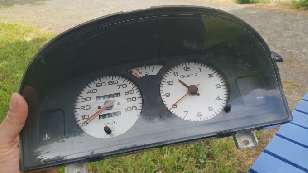
The second benefit? The odometer is a sealed unit so it couldn't be altered to reflect the true distance the car has travelled. So my 60770km car (give or take whatever it did with the speedo not working before purchase) is now an 8684km car. Well, that ought to bump up the resale value, huh? ☺
Repairing a Bifinett KH1171 bread maker.
I have a bread maker, a Bifinett KH1171.
I have two replacement belts.
Now to merge the two.
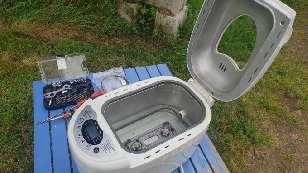
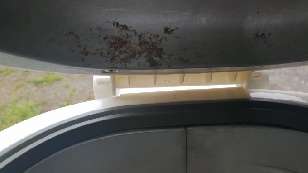
It should go witrhout saying but... if you decide to use sharp objects to remove the screw covers, take the necessary precautions to avoid loosing parts of your anatomy...or find a competent child who will do the job for you.
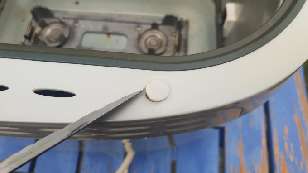
As I didn't remember what screwdriver I used last time, I Blue Petered something together with my adjustable wrench...
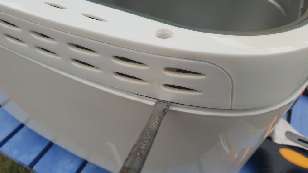
Do not try to pull the top off. You cannot. The ribbon cable connecting the controller computer to the drive circuitry is soldered at one end and glued at the other.
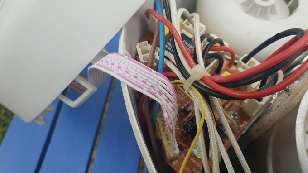
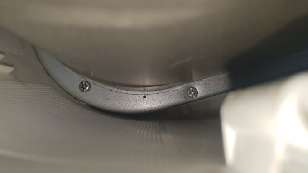
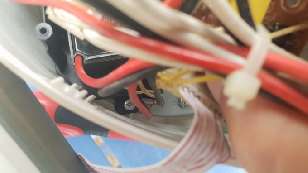
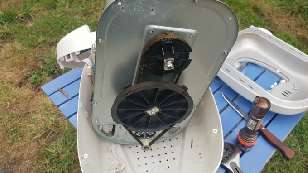
There is absolutely no play in the drive belts and putting them in place needs them to be a tad longer than they are. We're talking a millimetre here, but it's a millimetre they don't want to offer you.
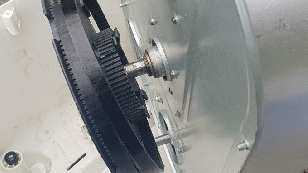
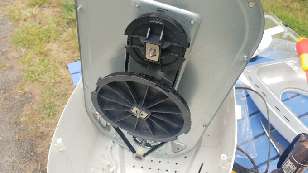
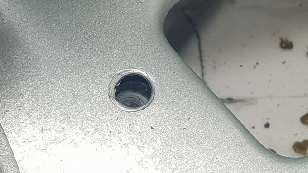

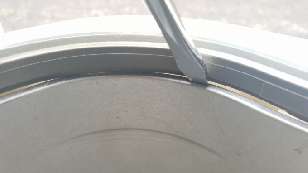
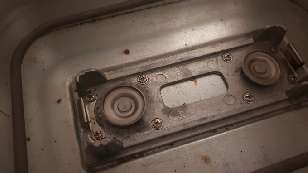
Start the cycle again. The cogs ought to turn now.
Let the cycle run for a few minutes. It will begin by pulsing a little (mixing up the dough and water), and then switch to turning a lot (the kneading). Let it do that, get everything moving.
When the kneading stops, it's done. It's the second proving and then baking. If it's all good so far, then you can look forward to some freshly made bread...in another two hours!
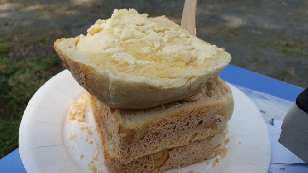
Rob, 24th April 2020, 22:29 David Pilling, 25th April 2020, 15:27
Glad to hear about the car, sounds like a good job.Miriam Fucik, 23rd July 2024, 20:32 Kaiva, 8th August 2024, 20:13
| © 2020 Rick Murray |
This web page is licenced for your personal, private, non-commercial use only. No automated processing by advertising systems is permitted. RIPA notice: No consent is given for interception of page transmission. |